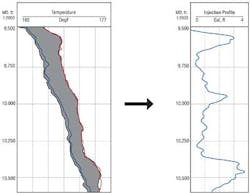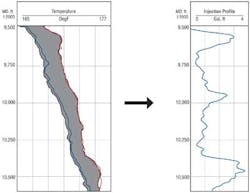New DTS interpretation improves matrix acidizing offshore Mexico
Lizeth A. Inda Herrera
Emmanuel O. Soto Lopez
Marco Antonio Castillo
PEMEX
Pierre Ramondenc
Andrea L. Murillo Vallejo
Israel Rosado Rivero
Miguel G. Romandia
Schlumberger
Enhancing production in carbonate formations using the principle of matrix acidizing seems deceivingly simple. Typically, acid is injected into the formation at pressures below the fracturing pressure to dissolve the carbonate minerals (calcite and dolomite) and bypass the near-wellbore damage by creating dissolution channels called "wormholes." The intended result is improved permeability in the matrix nearest the wellbore. Despite the seemingly simple process, matrix stimulation treatments often fall short of expectations because of limited knowledge of the rock morphology and petrophysics.
Without proper knowledge of parameters including the inherent double porosity and high permeability contrasts of carbonate rocks, the variable extent of damage, the presence of natural fractures, and the existence of differential pressure between reservoir layers, the acidizing treatment design is far from optimized. Controlling the placement of stimulation fluids remains one of the main challenges during matrix acidizing treatments in carbonate reservoirs.
This was a particular challenge forPEMEX in its efforts to revitalize production in its main offshore Gulf of Mexico fields, which experienced a rapidly declining production curve year-on-year. Historically, the stimulation process consisted of pumping large volumes of acid-based treatment into the formation, but with little control on zonal coverage.
Optimum fluid placement typically relies on two distinct steps: 1. Figuring out where along the wellbore acid and diverter fluids need to be injected to ensure that the reservoir will produce to its maximum capacity; and 2. Physically placing those fluids into the proper intervals. PEMEX used conventional coiled tubing (CT) to address fluid placement, using jetting tools to remove damage at the tubular and perforation holes and energize the treatment in the desired area. To evaluate where and how much fluid was injected into each zone, the operator initially used radioactive tracers. However, this method was not sufficiently accurate, and the radioactive tracers posed safety risks as hazardous materials.
Help from fiber optics
The Schlumberger ACTive family of live downhole CT services was selected for real-time treatment monitoring of subsequent matrix acidizing jobs. The ACTive CT services convey live downhole measurements on fiber-optics, telemetry-enabled CT, and consist of a bottomhole assembly (BHA), surface electronics and interpretation software. Downhole data, including internal and external pressures, temperature, casing collar locator, gamma ray and distributed temperature sensing (DTS), can be used for various intervention operations independently. However, PEMEX was most interested in how these measurements can be used collectively to optimize acidizing.
The efficiency of CT matrix stimulation can be improved through live monitoring of injection rates and downhole pressure and temperature to ensure that maximum fluid penetration and diversion are achieved, leading to optimized treatment volumes. The real-time process improves treatment performance and enhances the design of subsequent CT matrix stimulation.
An additional service known as DTS inversion improves the speed and the confidence with which the operator responds to the temperature readings recorded downhole to make actionable changes to the stimulation program. Conventional DTS enables the equipment to record temperature readings at several predetermined depths over time, creating a survey that qualitatively identifies fluid movement into the treated pay zones based on the formation's cool-down/heat-up effects. This technique had some limitations, however, as the data recorded needed to be converted, interpreted, and then translated into oilfield usable graphics and data tables. The time required to get a final result from the readings was often so long that the window to modify the current treatment to improve the well response was, on most occasions, already closed.
Moving interpretation to real time
DTS inversion shifts interpretation from qualitative to quantitative through a module containing an inversion algorithm coupled with fluid placement and thermal models.
This has several advantages. It is a step toward quantification of treatment effectiveness, since the tool output is a fluid coverage profile. Engineers can identify the injection ratios of the treatment flow within the interval(s) of interest. It can be used to carry out a sensitivity analysis on design parameters that were known with little certainty, and thus gain a better understanding of the temperature evolution post-stimulation. In addition, the inversion algorithm is fast enough – typically taking only minutes to run. It speeds and refines the evaluation of treatment effectiveness and provides new opportunities for fast corrective actions if required (e.g., need for diversion or re-stimulation of a particular zone), and a real-time optimization of the ongoing job.
An effective DTS interpretation using the inversion method in PEMEX's carbonate acidizing jobs followed this procedure:
1. Run-in-hole (RIH) to the desired depth (i.e., below all the pay zones to be evaluated), keep the CT stationary, and shut in the well. An accurate depth correlation must have been done to make sure that the recorded measured depth (MD) is accurate.
2. Without moving the CT, start acquiring the DTS survey. Monitor wellbore temperature evolution and confirm temperature stabilization before stopping the survey. This first DTS survey will be used to define the baseline geothermal profile and is crucial for the later inversion process, as it measures the initial conditions.
3. With the well still shut in, perform the first stage of the matrix stimulation treatment. The CT string can move during the treatment. Should bullheading be used, the CT is kept stationary and DTS data are recorded while the first treatment stage is pumped down the annulus of the CT and the well tubing. This DTS acquisition can help make sure that the bullheaded fluids can reach the bottom of the interval.
4. As soon as pumping stops and all the treatment fluid is injected, shut the well in and start the DTS acquisition to monitor the post-treatment temperature evolution in the wellbore. If the CT was moved during the previous stage, it must be placed back to the same depth as the first survey before starting the acquisition. Initiate a new DTS survey to monitor the post-treatment temperature evolution in the wellbore. This acquisition should take at least three hours to give sufficient time for the thermal exchanges and exothermic reaction heat to develop at the reservoir level. This survey will be used in the inversion process to evaluate the formation admittance of the treatment fluids.
5. Process and analyze the temperature data using the DTS inversion and derive the fluid invasion profile.
6. Depending on the results, the operator may redesign the treatment, pump extra stages, apply diversion to the zones that were identified as thief zones, or kick off the well to flow back the stimulation products.
7. If the operator decides to pump extra stages, the subsequent treatments shall maintain the shut-in condition and steps three to six shall be repeated until the outcome is deemed satisfactory.
Displaying 1/3 Page 1,2, 3Next>
View Article as Single page

